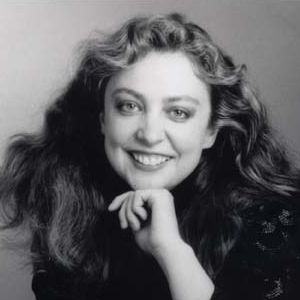 SPONSORED: An Outstanding Evening - Bill Newman listens to American pianist Rorianne Schrade.
SPONSORED: An Outstanding Evening - Bill Newman listens to American pianist Rorianne Schrade.
All sponsored features >>
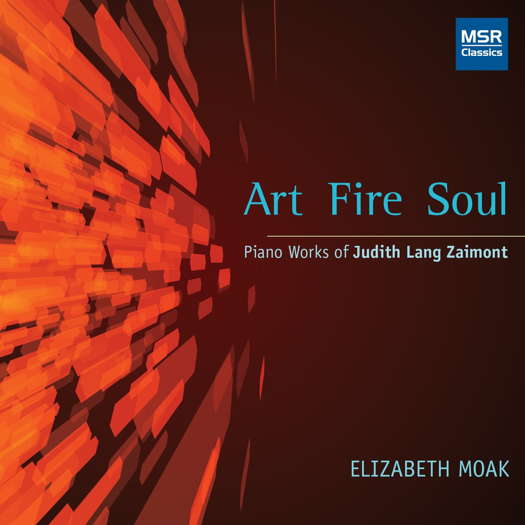 SPONSORED: CD Spotlight. An Encyclopedic Recital - Elizabeth Moak plays Judith Lang Zaimont, heard by the late Howard Smith.
SPONSORED: CD Spotlight. An Encyclopedic Recital - Elizabeth Moak plays Judith Lang Zaimont, heard by the late Howard Smith.
All sponsored features >>
- Chabrier
- Divine Art Record Company
- Rafail Kasimov
- Sydney
- funding classical music
- Luís de Freitas Branco
- Shanghai International Musician Competition
- Musgrave: For the Time Being: Advent
A Curiously Unfamiliar Masterpiece
MALCOLM MILLER is impressed by Hana Mizuta-Spencer's performance of Ernest Bloch's Violin Concerto
Ernest Bloch's Violin Concerto is a curiously unfamiliar masterpiece. Whilst it has an illustrious performance and recording history, premiered by Joseph Szigeti in 1938 under Mitropoulos, and subsequently taken up by Yehudi Menuhin who recorded it in the 1960s, with further recordings by leading artists in the 1990s and 2000s, it is seldom encountered in concert. Happily, the work recently found powerful advocates in the talented young violinist Hana Mizuta-Spencer, soloist with the North London Symphony Orchestra (NLSO) conducted by Robert Max, their musical director and an outstanding cellist. Their stirring account of Bloch's Violin Concerto formed the centrepiece of an enjoyable concert on 25 March 2023 at St James' Muswell Hill, London, UK, programmed alongside works by Dvořák and Musorgsky / Ravel.
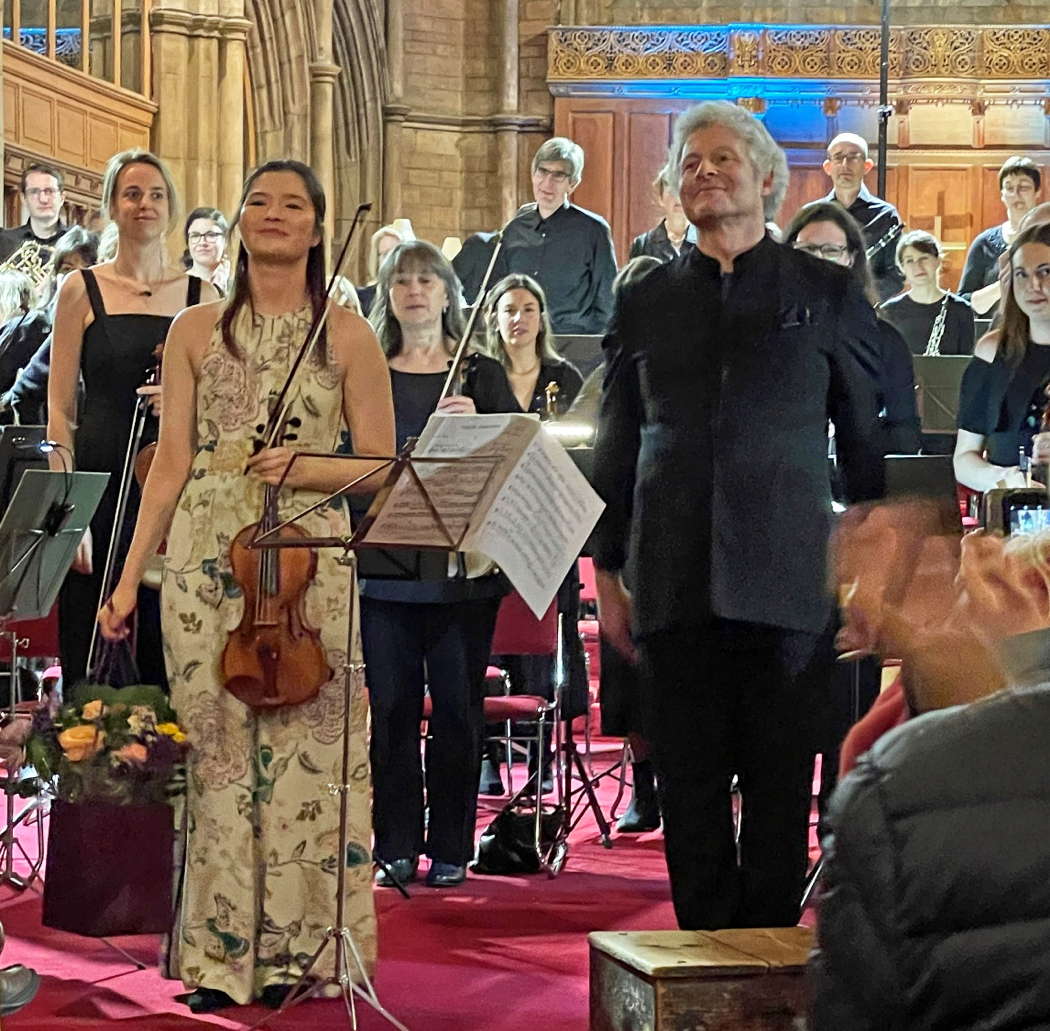
Hana Mizuta-Spencer, Robert Max and members of the North London Symphony Orchestra. Photo © 2023 Judy Obrart
The capacity audience in the very spacious, and amply resonant church displayed warm enthusiasm at the end of their superb performance which attested to the work's power that sets it alongside better-known works by Bloch such as his Schelomo for cello and orchestra.
The peripatetic genesis of the violin concerto reflects the composer's own transcultural identity: conceived in 1930 in San Francisco, it was mostly composed in Paris during 1935-7, completed in January 1938 in Bloch's native Switzerland, shortly before his return to the USA, where it was premiered later that year, and where Bloch remained until his death in 1959. Situated stylistically somewhere between the rhythmic energy and polyphonic clarity of Stravinsky and Prokofiev and the exploratory modality of Vaughan Williams and Hindemith, it incorporates many of the gestures of Bloch's earlier orchestral writing, including his 'Jewish cycle', yet it is abstractly symphonic in scope. The solo writing is highly idiomatic, attesting to Bloch's numerous works for strings, and significantly he took up the violin after a break of nearly forty years - he had studied in his youth with Ysaÿe - during its composition. Perhaps also significant is that the following year, 1939, saw his orchestration of the early 1923 Baal Shem Suite for violin, adding to his concertante oeuvre.
Bloch's distinctive voice emerges at the very start where Robert Max drew out just the right atmosphere to enable the soloist's rising melody, alternating rocking seconds and rising fourths and fifths to evoke the opening stillness and brooding quality so reminiscent of Vaughan Williams' The Lark Ascending. Hana Mizuta-Spencer, an award winning graduate of the Guildhall School of Music and Drama and a prolific soloist and chamber musician, proved an ideal interpreter, having pursued her own in-depth study of a piece still unfamiliar to many leading violinists. Her confident and yet highly variegated tone was an eloquent foil to the propulsive motifs of the rich orchestral texture, often in dialogue with soloistic woodwind and brass.
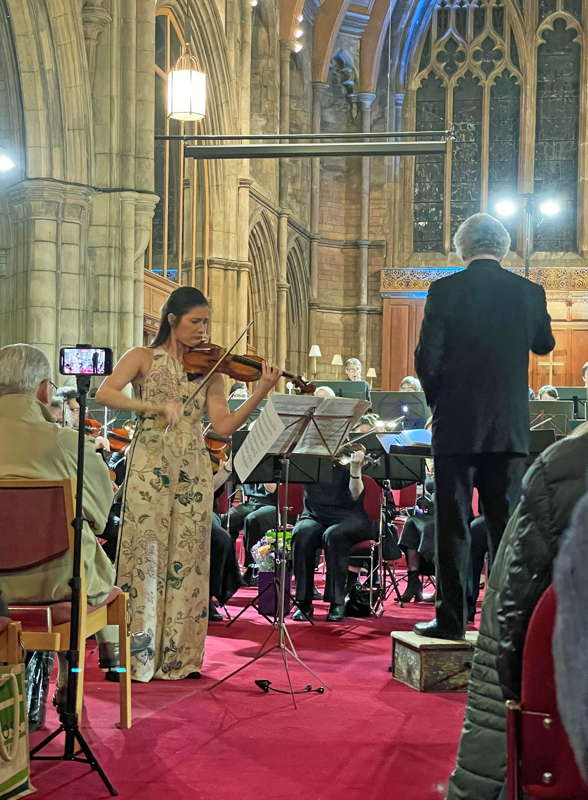
Hana Mizuta-Spencer playing Bloch's Violin Concerto, accompanied by Robert Max and the North London Symphony Orchestra. Photo © 2023 Judy Obrart
Her tone was always clearly projected above the energetic tuttis, with martial rhythms etched in side drum, weaving virtuoso filigree in the upper registers and soaring at grandiose climaxes. The movement is large scale – almost of the proportions of an entire three movement concerto - with a slower second subject acting as a second movement, before the faster final section which features the solo cadenza. Here Hana Mizuta-Spencer drew ravishing colours extending over the whole violin range, full of dramatic double stopping and soaring to stratospheric high registers, before restating the two-note motive of the initial subject which dovetailed smoothly into the orchestra's rousing conclusion.
Exotic scoring also permeates the expansive slow movement with its pastoral character reflected in the initial beautifully shaped woodwind theme, over which Mizuta-Spencer's silvery violin timbre glided imperceptibly at first, later tracing high patterns over wind and harp pedals whilst the arc-shaped narrative intensified to its peak with rich string textures, before receding to the initial calm. The soloist produced a ravishing sound again inhabiting the rarefied highest registers, fully alert to the mercurial changes of register across the wide-ranging solo part, exploiting harmonic intervals of fourths and fifths in dialogue with the soloistic orchestra.
The final movement retrieves the incisive energy of the start, with strident impetus contrasted by the soloist's broad lines counterpointed by a new zestful dancelike counter theme in the major mode. Again one could savour Mizuta-Spencer's enthralling tonal projection in her expressive dialogues with woodwind and brass, building up a sonic tapestry to ebullient climaxes with Hollywoodesque opulence and zest. The audience ovations were much deserved by all involved, both for the excellence of the performance itself as too for the sheer effort to champion a work of substance still too unfamiliar.
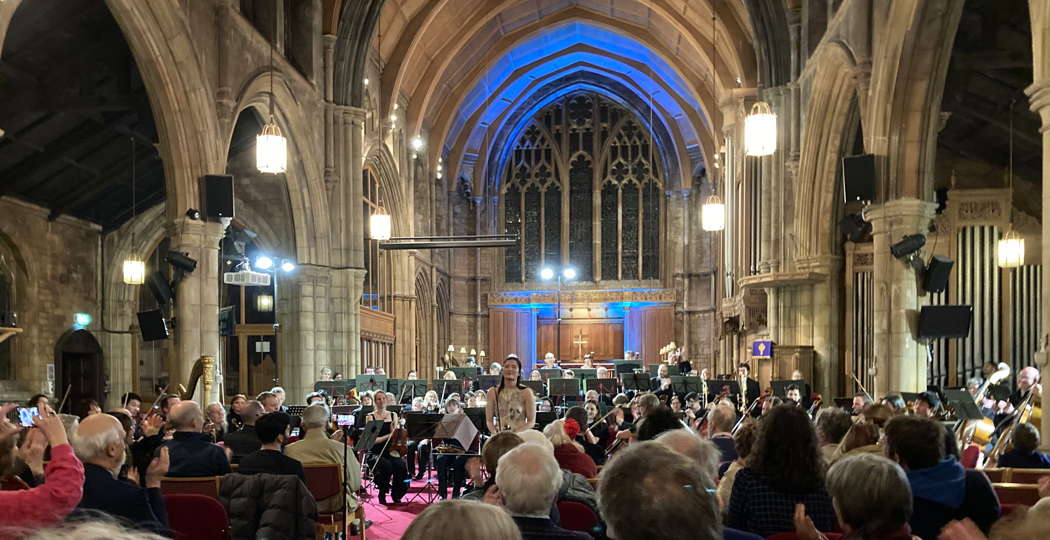
Hana Mizuta-Spencer acknowledges her applause at St James' Muswell Hill.
Photo © 2023 Malcolm Miller
One hopes Hana Mizuta-Spencer may perform the concerto again with a fully professional orchestra in the not-too-distant future. Fortunately, both soloist and conductor are scheduled to repeat it with the Oxford Symphony Orchestra on Saturday 16 March 2024 at 7.30pm in Oxford Town Hall, a performance well worth booking in advance via oxfordsymphonyorchestra.org.uk
The concert opened with Dvořák's vividly pictorial symphonic poem The Noon Witch, the NLSO painting each character in this troubling fairy tale: a young boy, his parents and the fearsome witch, with poignant and piquant details. Max elicited some impressive playing from the high-quality amateur orchestra both here, and again in their equally illustrative rendition of Ravel's orchestration of Musorgsky's Pictures at an Exhibition. Especially telling were Ravel's 'special effects', the dreamy saxophone solo of 'Il Vecchio Castello', the eerie 'Catacombs' and splendour of the 'Great Gate of Kyiv', the audience regaled with a thrilling climax in the final bars.
Copyright © 31 March 2023
Malcolm Miller,
London, UK



